FlightLineRC P-38L Lightning
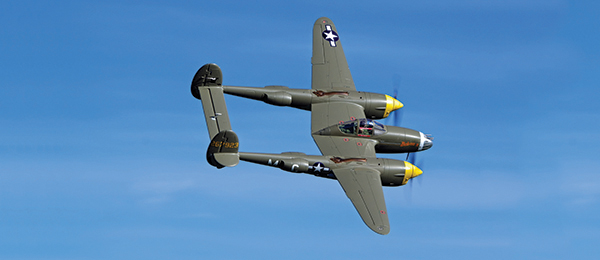
Written by Jon Barnes Fly the famous fork-tailed devil Product review Photos by the author As seen in the April 2016 issue of Model Aviation.
Specifications:
Model type: Electric-powered warbird Skill level: Intermediate Wingspan: 63 inches Wing area: 600 square inches Length: 46 inches Weight: 111 ounces Power system: Twin brushless electric Radio: Minimum six-channel transmitter Construction: EPO foam Covering/finish: Factory painted with graphics included in the kit Street price: $349.99Test-model Details
Motors used: Two 3748-600 Kv brushless outrunners (installed) Speed controllers: Two 60-amp with 5-amp BEC (installed) Propellers: 12 x 7 three-blade (installed) Battery: Two Admiral Pro 4S 14.8-volt 50C 2,500 mAh LiPos; or Admiral 4S 14.8-volt 35C 3,000 mAh LiPos Radio system: Spektrum DX9 Stealth DSMX 2.4 GHz nine-channel transmitter; Spektrum AR7010 DSMX 2.4 GHz seven-channel receiver Ready-to-fly weight: 125 ounces using two Admiral 4S 14.8-volt 35C 3,000 mAh batteries Flight duration: 5 to 7 minutesPluses
• A satisfyingly large version of the most exciting, instantly recognized, and historically significant twin-powered World War II-era warbird. • Available in Pacific Silver or Allied Green color scheme; both feature extensive squadron and maintenance graphics. • Inboard/outboard split flaps, sequenced gear doors, and electric retracts. • Plenty of space for batteries and receiver beneath the conveniently long, removable canopy/hatch. • Gear wells and inner surfaces of flaps are painted an authentically scale zinc chromate green color. • Molded-into-the-foam wiring troughs and control interface board help tame the abundance of wiring inherent to a twin model. • Landing light in the wing’s leading edge is only lit when the gear is deployed. • Ball link connections used on the control surface side of all pushrods.Minuses
• Silver-colored elevator counterbalances did not match the zinc chromatic green of the horizontal stabilizer. • Fasteners used to attach the center section of the main nacelle to the wing’s center section were too short.Product review
In a short time, Motion RC has become a one-stop shop for pilots who love warbirds and EDF-powered jets. Although its diverse product inventory is not limited to these two types of models, Motion RC’s development of strategic partnerships with several prolific, overseas-based manufacturers has resulted in a seemingly endless supply of new and exciting must-have warbird and jet models. Add in the fact that Motion RC stocks a complete selection of parts for the aircraft that it sells, and its quick rise to popularity among pilots comes as no surprise. Its announcement in early 2016 about the Motion RC-exclusive new FlightLineRC brand of models has put warbird enthusiasts on high alert, and for good reason. Although the release of three propeller-driven warbird models was initially announced to springboard this new Motion RC-developed brand, the centerpiece of the new FlightLineRC trio is undeniably the 1,600mm-wingspan, electric-powered, EPO foam-composition P-38 Lightning. As the associated marketing materials mention, this P-38L is currently the largest mass-produced foam P-38 in the world! It is a model that many fork-tailed devil aficionados have clamored for. Many of the staff members at Motion RC actively participate in a number of the forum-based sites. The company sponsors a forum-based discussion site at HobbySquawk.com, actively aggregating the preferences and opinions of pilots when developing new models. The list of pilot-pleasing features included with this exciting new P-38L is proof that it benefited from this unique approach to product development. Foremost among the features that will have twin-warbird-loving pilots grinning is the fact that this model is large and its wingspan qualifies it as a 1/10-scale replica of the full-scale Lightning. The fully retractable tricycle gear, driven by electric retracts, benefits from servo-driven sequenced gear doors to keep things tidy and clean while in flight. The four inboard and outboard split flaps are each driven by their own servo. I was especially impressed to find that the gear wells and inside surfaces of the flaps were all painted an authentic-looking zinc chromate green!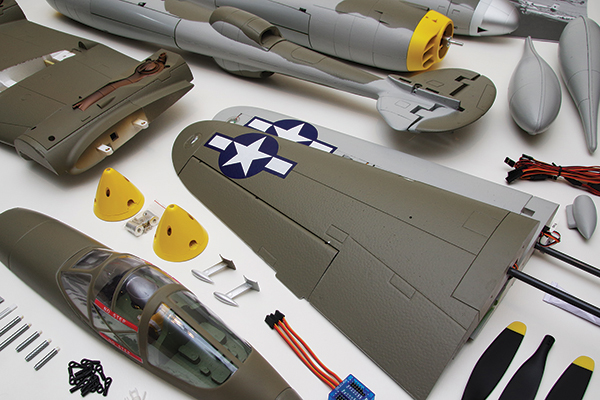
Also available in a brightly finished Pacific Silver color scheme, the author was enamored with the dull green and gray finish of the Allied Green scheme.
Twin-powered electric models inherently have a bewildering abundance of servo leads and power wiring. FlightLineRC helps keep the wiring neat and manageable by including wiring troughs in the wing’s center section. The wing’s center section also features a notably thick, embedded aluminum spar that appears to anchor what the company describes as an airframe that is carbon reinforced in critical locations. Having owned and flown several smaller P-38 models, most of which had limited space for the receiver and flight battery, I was anticipating the same crowded under-the-canopy scenario. However, the P-38’s center nacelle possesses ample space for receiver installation and flight batteries, and access to all of these components is almost completely unrestricted, thanks to a removable canopy that runs nearly the entire length of this nacelle! A set of preinstalled brushless power systems and scalelike three-blade counter-rotating 12 x 7 propellers are listed as being able to pull the P-38 along at speeds of roughly 80 mph. Motion RC offers a higher-performance power system that uses more conventional, but less scalelike, two-blade propellers to boost the top speed by 10 to 15 mph.
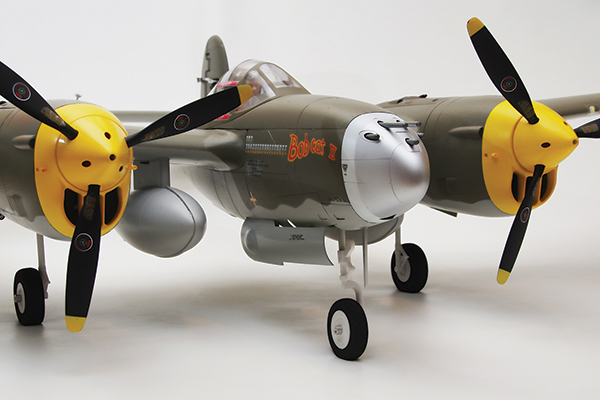
The big 12 x 7 three-blade propellers counter-rotate as they do on the full-scale P-38 Lightning.
Most pilots like being able to customize the appearance of their military aircraft. Motion RC provides pilots with several ways to personalize this model. The aircraft is offered in an Allied Green or a Pacific Silver color scheme. Additional options are included in the form of a large sheet of squadron graphics. Pilots can choose between four sets of squadron graphics if they go with the Allied Green P-38, while the graphics in the Pacific Silver kit allow pilots to model their P-38 after four aircraft from the 431st Squadron. Other graphics with the package that enhance the model’s scale realism include a sheet of “maintenance” lettering and water-slide vintage Curtiss propeller graphics.
Construction
Although a plug-and-play kit, the FlightLineRC P-38L comes with a surprisingly thick assembly manual. The 50-page black and white manual is written in three languages and is peppered with an abundance of CAD-style 3-D graphics. The manual is so thoroughly illustrated that a pilot could probably use it to completely assemble this model in the same manner as the FlightLineRC factory personnel do. Although most pilots will not need the level of detail offered by the manual to make their way through assembly in preparation for flight, should any part or piece of the airframe suffer crash damage and need to be replaced, the manual would be a valuable resource. Like many modern kits, the basic airframe can be assembled without needing one drop of adhesive. By my count, 19 fasteners are used to assemble the P-38’s airframe—15 of which are Phillips-head metal screws that thread tightly into plastic receivers. Alternately, the outer wing panels are attached to the tailboom sections using machine-thread screws. These screws mate into brass-colored, threaded metallic inserts. Using this method of attachment for the outer wings is wise because metal-to-metal machine-thread connections can be unthreaded and rethreaded almost an unlimited number of times with no loss of holding power. Try that with a metal-to-plastic connection! This design feature allows transport-challenged pilots to easily break down the airframe to a convenient size. Removing the outer wing panels will require that a pilot disconnect the aileron servo leads, outboard flap leads, and embedded navigation and landing lights wiring. I had a little difficulty when it came to the five fasteners used to attach the center nacelle/cockpit to the wing’s center section. Although the manual calls out the fasteners to be used as being 10mm in length, I found that the two in the center of the assembly needed to be slightly longer in order to reach their final destinations. Rummaging around in my parts bins, I found some slightly longer fasteners that got the job done. Pilots building this kit will also need to assemble and install the pushrods. Thanks to the inboard and outboard flaps, there are quite a few of them used on this model. The manual lists the length of each pushrod, as well as the recommended holes in which to place them on both the servo horn and control horn. This model uses ball-link connectors on all of the control surfaces. The servo ends of the pushrods are a simple 90° bend that is secured in place using snap-on plastic retainers. The P-38L comes out of the box with a whopping 13 preinstalled servos. Most of these are 9-gram, metal-gear servos. The only exceptions are the servos that operate the gear doors and the elevator servo. The former are 9-gram servos with plastic/nylon gears, while the latter is a higher-torque 17-gram, metal-gear servo. As can be expected when assembling a full-featured twin electric model, the wiring can be daunting. FlightLineRC included a small, integrated circuit board module, simplifying the connections of the control surface servos, retracts, gear door servos, and embedded lights. Stowing the Spektrum AR7010 seven-channel receiver, integrated circuit module, and the excess lengths of all of the servo leads into the large, square recess that is molded into the aft end of the center nacelle was not an issue. The satellite receiver was hot glued in place approximately 6 inches forward of the main receiver.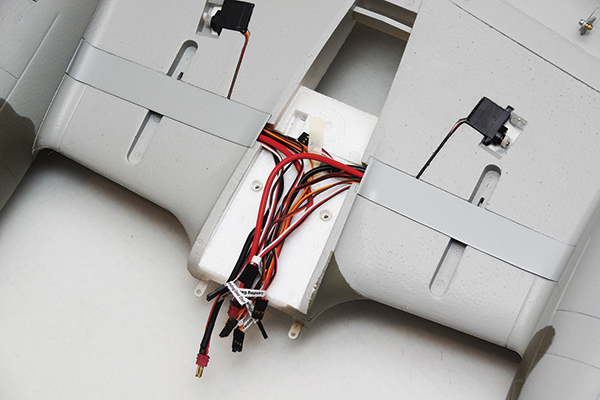
Well designed and deeply dimensioned troughs in the center section of the wing keep the wiring neatly concealed.
After the main airframe is assembled, builders will have to break out a little adhesive. FlightLineRC includes a nice selection of scalelike add-ons that give the P-38 an authentic scale outline. The company did an impressive job of recreating the exposed twin turbochargers. The paint recreates the appearance of aircraft components exposed to extremes in both weather and regular operating temperature cycles. Although these two details come glued in place on the tailbooms, I used the included contact-style adhesive to attach the antenna mast, the elevator counter-balances (which were painted silver instead of the olive drab of the elevator), the five gun barrels, the drop-tank pylons, and the outer horizontal stabilizer assemblies. The two bulbous drop tanks snap into place on the pylons using strong magnets. After the model is fully assembled, pilots who prefer to make the P-38 as scalelike as possible will want to apply the included graphics. FlightLineRC includes placement guides for both the squadron and maintenance graphics. These graphics feature a clear, glossy overlay that must be carefully peeled away after the graphics are placed on the model. Applying all of the tiny maintenance graphics took time, but the results are more than worth the effort. Six sets of vintage-looking Curtiss propeller graphics are also included. The assembly manual provides all of the necessary data to program one’s transmitter and prepare the P-38 for its first flight. FlightLineRC provides recommended settings for high and low rates and the all-important recommended center of gravity (CG) measurement. The assembly manual illustrates the direction that each of the counter-rotating propellers needs to turn, but it does not offer obvious guidance when it comes to mounting each propeller to the correct motor. I used the illustrations on the assembly manual’s cover as my guide. The manual’s recommended control throws were used. This included setting the elevator’s neutral position to negative 4mm and adding a little down-trim compensation during both stages of flaps deployment. I typically like to soften the response of the pitch and roll axis with 40% exponential, dialing that figure back to 25% on the yaw axis.
Flying
A pair of 3,000 mAh LiPo battery packs was used for the maiden flight with a conservative countdown timer of 5 minutes. As a point of reference for pilots trying to decide which batteries to use in this model, a pair of the Motion RC-recommended Admiral 35C 4S 3,000 mAh packs weighed in at 21 ounces and a pair of the also-recommended Admiral Pro 50C 4S 2,500 mAh packs weighed 20 ounces. With plenty of extra space in the battery compartment, either set of batteries can be shifted fore and aft to achieve the correct CG. Although the Allison V-12 engines used in the full-scale P-38 provided 1,600 hp each, the 575 watts of power produced by each of the two brushless power systems used in this 1/10-scale model give it a comparatively blistering rate of acceleration.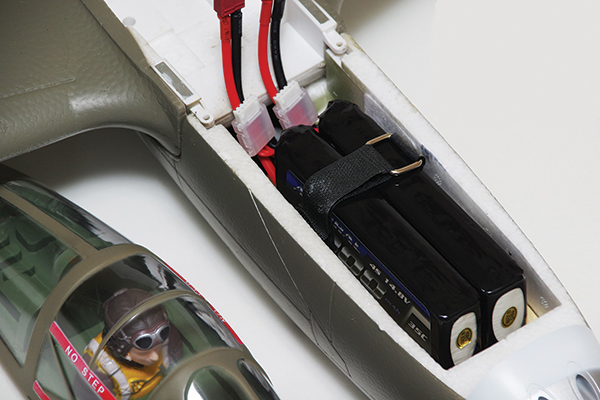
With two 4S 3,000 mAh LiPo battery packs, there is still sufficient room under the canopy to shift the batteries fore and aft in order to hit the proper CG.
In order to perform a scalelike takeoff, I slowly and deliberately advanced the throttle. Pilots who have developed the habit of gunning and running their taildragger-equipped warbirds on takeoff to avoid dealing with the tracking challenges caused by propeller torque, will enjoy this model’s tricycle gear and counter-rotating propellers. The P-38 tracked well during both taxi testing and takeoff. When deployed to the takeoff position, the four inboard/outboard flaps do a great job of reducing the amount of runway required to get this nearly 8-pound model airborne. With the gear retracted and half flaps left deployed, the nose did fall through a little. A few quick clicks of elevator trim (later corrected by reducing the amount of flap-to-elevator trim) had the Allied Green P-38L Lightning flying hands off at 50% throttle. Slowing the movement of the flaps in the transmitter programming, if so equipped, can help mitigate most of the pitch changes associated with flap deployment. After the model was trimmed out and the flap-to-elevator mix properly tweaked, the P-38 exhibited hardly any discernible pitch changes when using the flaps. The initial flights occurred on a nearly windless day. With the flaps stowed and the twin 12 x 7 three-blade propellers spinning at full rpm, this big P-38 grooves nicely! I found that it would go exactly where I aimed it, and it required minimal corrective-control inputs to hold its lines. Top speed with the stock power systems is roughly 80 mph and it is enjoyable racing the P-38 around the pattern at full throttle. With slightly less than 150 watts per pound of performance on tap, the Lightning really rips! Aileron rolls were crisp, with a surprisingly efficient roll rate. Inverted flight required holding a shade of down-elevator in the turns. The twin brushless outrunners lurking beneath the bright yellow cowls provide enough punch to perform large, sky-filling loops. Although pilots who live for speed might want to explore the optional higher-performance, two-blade power systems offered by FlightLineRC, this model’s overall scale in-flight appearance and performance using the stock power systems and three-blade propellers, is pleasing. On one of the first flights, the model was repeatedly paraded up and down the flightline with the goal of capturing plenty of photos. With the throttles seldom pushed above 50% during this photo flight, 5 minutes of flying depleted a mere 1,100 mAh from each of the two Admiral 3,000 mAh batteries I was using. Landing a warbird model properly often “separates the men from the boys,” and this airplane can make a pilot look mature beyond his or her years! The P-38 is well behaved throughout the entire conventional landing pattern. Getting the model back down to the runway in a scalelike fashion was not difficult. With the flaps fully deployed and the landing gear dropped, the P-38 bled speed nicely. Any hint of an impending stall with everything down and dirty is signaled with a subtle wing rock. When getting too slow in the pattern, quickly adding in a little extra throttle would immediately stabilize the model in the glide slope. Whether using full flaps, half flaps, or no flaps, this Lightning is generally a pussycat to land!
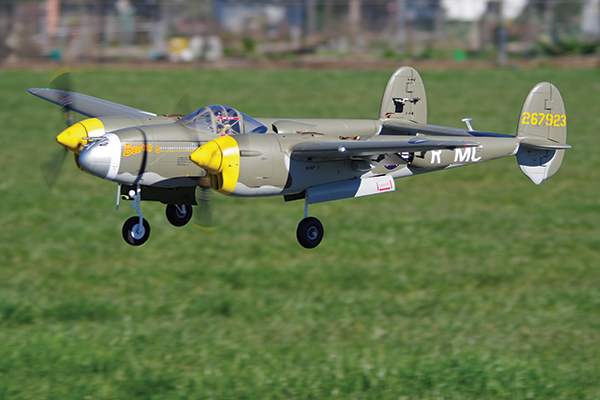
With the four flaps fully deployed and the electric tricycle landing gear down and dirty, this nearly 8-pound model safely slows to a manageable approach speed when in the landing pattern.
The full-scale Lockheed P-38L saw service in an amazing variety of roles throughout World War II. FlightLineRC’s inclusion of a pair of magnetically retained and removable drop tanks bears testimony to the critical role that it played as a long-range escort fighter. Flown both with and without the drop tanks, I noticed a slight increase in speed when leaving them off of the airframe, but the difference was negligible. I preferred the all-business appearance that they lend to the model, and chose to leave them attached for most flights. The magnets used to secure the drop tanks to the pylons are strong and did a great job of keeping them in place throughout the flight testing.










3 comments
Beautiful Jon!
I have a feeling there will
P-38 Article
Add new comment